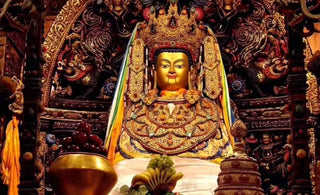
In the rich tapestry of Tibetan Buddhist artistry, the depiction of protector deities stands as a testament to the harmonious blend of spiritual symbolism and artistic mastery. These guardian figures, embodied in exquisite treasures such as the "18th Century Colorful Three-Eyed Guardian Buddha Statue Tibetan Cabinet From Central Tibet," transcend mere artistic representation, emerging as active defenders of the sacred teachings and spiritual seekers.
Within the ornate details of the 18th-century statue, the vibrant portrayal of the Three-Eyed Guardian deity captures the essence of protective forces in Tibetan Buddhism. The Guardian, adorned with intricate details and resplendent colors, becomes a visual symphony that resonates with the spiritual energies it symbolizes. As guardians of the Dharma, the teachings of the Buddha, these deities go beyond the aesthetic, embodying the dynamic interplay between the visible and the metaphysical.
The Three-Eyed Guardian, a prominent figure in Tibetan Buddhism, is often associated with Mahakala, the wrathful emanation of the Bodhisattva Avalokiteshvara. This wrathful aspect, depicted with multiple arms, fierce countenance, and symbolic adornments, serves as a potent symbol of protection against obstacles on the spiritual path. As devotees gaze upon the intricacies of the guardian's form on the statue, they are not merely witnessing artistry but engaging with a divine force ready to defend against adversities.
The chest itself becomes a repository of sacred energy, a tangible vessel holding the essence of protection and spiritual fortitude. Crafted with meticulous care, the chest mirrors the devotion poured into its creation, echoing the reverence with which the Three-Eyed Guardian is invoked in Tibetan Buddhist practices. The intertwining of artistic craftsmanship and spiritual significance transforms the statue into more than a storage piece; it becomes a sanctuary for the sacred, a guardian in material form.
Each element adorning the statue contributes to the narrative of protection. The three eyes, a distinctive feature of the Guardian, symbolize omniscience, seeing beyond the limitations of ordinary perception. The multiple arms, each holding symbolic attributes, convey the deity's ability to engage with myriad aspects of existence simultaneously. The vibrant colors, meticulously applied, evoke a sense of dynamism and spiritual vitality.
As the guardian figure adorning the statue gazes outward with a fierce yet compassionate expression, it becomes a visual anchor for those traversing the spiritual journey. The chest, with its ornate carvings and vibrant hues, transcends its utilitarian purpose, evolving into a sacred container of blessings and protection. In the presence of such treasures, practitioners find not only aesthetic appreciation but a source of inspiration and solace.
In the broader context of Tibetan Buddhist art, the synergy between protector deities and tangible treasures illustrates the dynamic relationship between the sacred and the worldly. The Three-Eyed Guardian, enshrined on the statue, becomes a conduit for the divine to manifest in the material realm. The act of crafting such treasures mirrors the spiritual journey itself, a meticulous process, guided by devotion and imbued with profound meaning.
As practitioners engage with the "18th Century Colorful Three-Eyed Guardian Buddha Statue Tibetan Cabinet From Central Tibet," they partake in a sacred dialogue with the guardian figure. The statue becomes a locus of spiritual communion, inviting devotees to seek protection, guidance, and inspiration. In this intricate dance between the sacred and the tangible, the chest emerges as a beacon of divine presence, resonating with the timeless legacy of Tibetan Buddhism. The Protector Deities, guardians and defenders embodied in such treasures, continue to stand sentinel, ensuring the continuity of the Dharma and offering refuge for those who navigate the intricate paths of the spiritual journey.
























